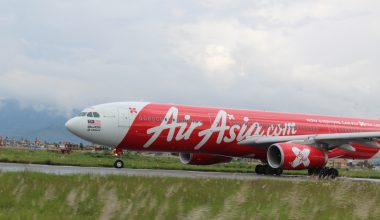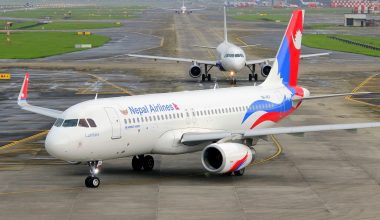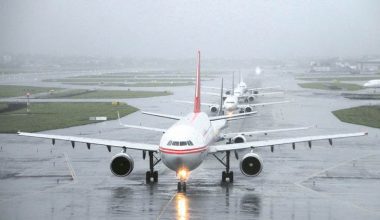Airbus is a household name for airlines worldwide as its aircraft are ubiquitous. If it’s not already obvious, the Airbus A320family (series of narrowbody airliners) is the most successful commercial aircraft family of the European aerospace giant Airbus, with more than 10000 jets built. In due course of time, Airbus has upped the game by launching A320neo ‘New Engine Option (neo), featuring redesigned wings, modern high-bypass ratio engines, increased fuel efficiency, and improved cabin experience. Airbus A321neo forms the backbone of the new program giving Airbus a competitive edge over its rival Boeing. Without any further ado, let’s look into the longest fuselage member of A320family-the Airbus A321neo.

Introduction to Airbus A321neo
Airbus A321neo is the lengthened A320neo family variant widely known for its unrivaled fuel efficiency, longer range, and expanded seating capacity. It is a large-gauge, single-aisle, narrowbody airliner developed by Airbus that entered commercial revenue service for the first time in May 2017 with Virgin America.
Powered by a new, more efficient CFM International’s LEAP-1A engine or Pratt and Whitney (P&W) PW1100G-JM geared turbofan engine, the A321neo makes long-range flights viable by facilitating routes of up to7400km; 400-500nm more than older A321s. This jetliner is a fuel-sipper as it delivers a 20% reduction in fuel consumption over its A321ceo counterpart. In addition to consuming 30% less fuel per seat, it emits 20% less CO2 and 55% less NOx per seat than the previous A321.
Also Read: Salam Air to start service to Nepal after receiving permission
The lower fuel burn and an additional range of up to 500nm come from the modern high-bypass ration engines and innovative blended winglet design called ‘Sharklet’.
Special features of A321neo
Airbus A321neo avails two advanced engine choices-LEAP-1A and PW1100G-JM geared turbofan, assisting in the aircraft’s great operational efficiency with more fuel and maintenance savings. These engines enable A321neo to be dispatched with less fuel and reach higher altitudes much faster than earlier A321s. The expanded range of 400-500nm and per-seat fuel improvements of 20% means airlines can fly longer distances much more economically with A321neos. They an

Along with excellent operational efficiency, A321neo advances environmental goals and supports airlines’ aim to be carbon neutral by delivering 22% and 55% reduction in carbon dioxide and nitrogen oxide emissions per seat, respectively. Furthermore, it has unmatched passenger appeal with a quieter cabin, creating almost 15% less noise than existing aircraft.
A321 neo has a maximum takeoff weight of 97 tonnes, maximum fuel capacity of 32,940 liters, and maximum landing weight of 79 tonnes. The 44.51m long and 11.76m high aircraft has an elevated wing loading and structural strengthening in the landing gear and wing.
A321neo benefits from the most optimal aerodynamic configuration with the addition of aerodynamic-enhancing Sharklets on the wings, which significantly reduce drag and fuel burn. It is an innovative winglet design fitted in the Airbus A320 family for optimal twin-jet operations.
A321neo shares commonality with A320 family members and forms the base for long-range A321LR and A321XLR (extra-long range) variants. The A321XLR is Airbus’ next evolutionary step for the A321neo featuring a maximum range of up to 4700nm in a two-class layout.
Airbus A321neo seating
As the longest fuselage A320 family member, A321neo has further enhanced the single-aisle jetliner offer by increasing the jetliner’s maximum certified capacity to 244 seats. Expanding seating capacity can accommodate more passengers than the ceo prototypes, leading to higher revenues. Available in multiple configurations, it can comfortably seat up from 180 to 220 passengers in a typical two-class seating configuration and up to 244 passengers in a single-class layout.
A321neo seating features a range of cabin elements and optimal use of cabin space to bring a totally new definition of cabin comfort for passenger convenience with standard 18-inch wide seats, plenty of spacious overhead bins, wider aisle, thoughtful finishes, winged headrests, etc. Passengers can stow their belongings in extra-large overhead bins which have room for eight carry-ons.

The new cabin layouts comprise the latest cabin and seat design innovation including the integration of new slimmer sidewall panels for extra personal space, redesigned bezels, integrated window shades, customizable lighting, integrated stands for tablets, and personal device, etc. As per the requirement of airlines, A321neo incorporates personalization and seamlessness to ensure uncompromised passenger comfort onboard the aircraft.
In addition to spacious passenger storage, A321neo has enough room to accommodate a maximum of ten underfloor pallets. It has a new cabin door configuration to complement the increased cargo volume. There’s a large cargo compartment cross-section and a facility to load pallets and containers on the lower deck.
Airbus A321neo inflight entertainment system
Depending on the airline, Airbus A321neo offers high-definition inflight entertainment screens and fast-streaming Wi-Fi throughout the cabin. A321neo inflight entertainment system keeps passengers entertained their whole flight by allowing them to stream the latest Hollywood hits, binge full box sets, a large collection of films, a library of games, and high-speed Wi-Fi connectivity.
Delta A321neo offers a wireless in-flight entertainment system and power ports at each seat to transform trips into moments of relaxation. Aboard Cathay Pacific’s A321neo, passengers can have access to 4K ultra-high-definition IFE screens and take in the latest blockbusters to kill their boredom. Lufthansa A321neo IFE also features the latest selection, classics of film history, music and games, TV shows, and more to enrich the passenger experience.
What’s the difference between A320 and A321neo?
Airbus A321neo is the evolution of the A320ceo (current engine option) with more efficient engines and increased seating density. The Airbus A320ceo (320-200) is powered by two CFM 56-5s or IAE V2500s and can fly at 6100km (3300nmi) carrying 150 passengers. On the other hand, A321neo is equipped with advanced CFM LEAP 1-A or PW1000G engines and can fly at 7400km carrying 180-220 passengers in a typical 2-seating class.
The older A320 versions, i.e., A320-100 and A320-200, entered into revenue service in 1988 and 1989, respectively, whereas A321neo was rolled out in 2017. While A320ceo still remains the best-selling A320family aircraft, A321neo is gearing up to surpass A320ceo in terms of order. Due to enhanced operational and cabin offerings, airlines have started phasing out A320jets in favor of fuel-efficient and evolutionary A321neo aircraft.
What’s the difference between A321 and A321neo?
A321neo has minimal changes to the baseline A321 in terms of powerplants and performance. Airbus A321 has two variants: A321-100 and A321-200. Equipped with V2533-A5 or CFM 56-5B3, A321-200 can fly at the range of 3200 NM (5926km) carrying 185 passengers and has a maximum takeoff weight of 93000kg. It operated commercial operations for the first time in 1997 on behalf of Monarch Airlines.
A321neo consumes less fuel than older A321s due to more efficient turbofans and improvements including sharklets. A321neo offers a more competitive edge for airlines by bringing per-seat fuel improvements of 20% and two tonnes of extra payload. While still retaining standard 18-inches wide seats, it can carry up to 244 passengers at once. The long-range A321neo can tap into new long-haul markets of up to 4000nm, creating new links between businesses and people.
Airbus A321neo price
The fuel-efficient Airbus A321neo is the robust workhorse of several airline fleets offering the best customer service in the industry with quieter and more spacious cabins and lower fuel burn. Airbus 321neo price is $129.5 million, which is around $20 million and $29 million more than $110million-priced A320neo and $101million-priced A320ceo respectively at the list price. Despite the high price, the trend of airlines replacing their aging fleet with more sustainable, fuel-efficient A321neo hasn’t changed.
Is Airbus A321neo safe?
Airbus A321 neo has an exceptional safety record with no hull losses and fatalities to date. First commercially launched in May 2017, the A321 neo has a clean flight record like its siblings such as A220, A319neo, A320neo, A340, A350, and A380.

A321neo operators
With Airbus stopping the production of A320ceo family aircraft, A321neo is sniffing at its heels and enjoying commercial skies with more than 4,189 orders (including LR and XLR) received far. As of April 2022, 725 A321neo are active in the fleet of several civilian operators.
India’s largest airline, IndiGo, is the largest operator of A321neos, with 56 units in its current fleet. Dallas-based American Airlines and Guangzhou-based China Southern Airlines follow the lead with 53 active units each. Airbus A321neo comprises a significant portion of the Hungarian ultra-low-cost Wizz Air fleet with 42 such aircraft.
Turkey’s national carrier, Turkish Airlines, operates 32 A321s. Similarly, Air China and JetBlue operate 22 and 21 A321s, respectively. Other A321operators include Sichuan Airlines (21), Vietnam Airlines (20), VietJet Air (19), TAP Portugal Airlines (19), Hawaiian Airlines (18), EasyJet (15), Lufthansa (14), etc. Alaska Airlines, Air Transat, British Airways, Cebu Pacific, Starlux Airlines, and Pegasus Airlines operate similar numbers of 321neos, which stands at 10.
Bottom line
In the light of growing concerns over aviation’s contribution to climate change and outrageous fuel prices, A321neo can serve as an ideal replacement for older aircraft and foster the overall development of carriers with higher fuel efficiency, low emissions, and superior customer experience.






